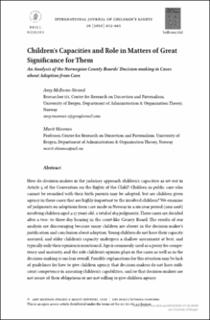Children’s Capacities and Role in Matters of Great Significance for Them
Journal article, Peer reviewed
Published version

View/
Date
2020Metadata
Show full item recordCollections
- Department of Government [457]
- Registrations from Cristin [9791]
Original version
https://doi.org/10.1163/15718182-02803006Abstract
How do decision-makers in the judiciary approach children’s capacities as set out in Article 5 of the Convention on the Rights of the Child? Children in public care who cannot be reunified with their birth parents may be adopted, but are children given agency in these cases that are highly important to the involved children? We examine all judgments on adoptions from care made in Norway in a six-year period (2011-2016) involving children aged 4-17 years old, a total of 169 judgments. These cases are decided after a two- to three-day hearing in the court-like County Board. The results of our analysis are discouraging because many children are absent in the decision-maker’s justification and conclusion about adoption. Young children do not have their capacity assessed, and older children’s capacity undergoes a shallow assessment at best, and typically only their opinion is mentioned. Age is commonly used as a proxy for competency and maturity, and the role children’s opinion plays in the cases as well as in the decision-making is unclear overall. Possible explanations for this situation may be lack of guidelines for how to give children agency, that decision-makers do not have sufficient competency in assessing children’s capabilities, and/or that decision-makers are not aware of their obligations or are not willing to give children agency.
